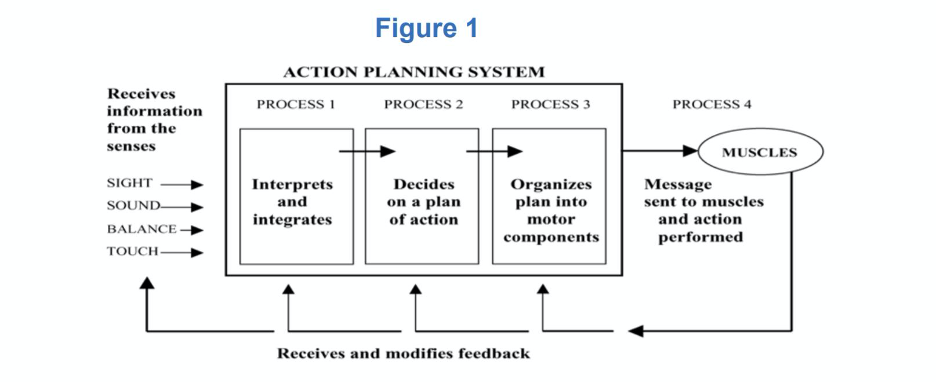Dyspraxia / DCD
Dyspraxia vs Developmental Coordination Disorder. Clumsiness Symptoms
Energetic kids can be clumsy – really clumsy. But, when clumsiness affects a child’s ability to take care of himself, participate at school, and enjoy fun with friends, there might be something else going on.
When child clumsiness symptoms begin concerning parents, they might find a wealth of disorders that affect the motor skills of child. We’ve talked in the past about dyspraxia and sensory processing disorder, so today I want to unpack children with developmental coordination disorder symptoms.
Developmental Coordination Disorder DCD is a bit of an umbrella term for children who suffer from a lag in developmental motor skills. There are several different developmental disorders that can all affect a child’s motor skills and subsequently dexterity and coordination.
As a paediatric occupational therapist who specialises in sensory and motor skills disorders, I’ve spent my career helping parents identify and understand a variety of conditions that affect motor skills and present as child clumsiness symptoms. I know how confusing it can be when a child has a diagnosis of DCD.

Also know that there are a lot of interchangeable terms in our industry that can be confusing for parents around the world. Motor skills, sensory-motor skills, motor coordination, fine motor, gross motor, etc.
Those are all phrases that can be used interchangeably. Looking at a child or adult with dyspraxia or with Developmental Coordination Disorder (DCD), only minor differences will be noted.
Both will present with clumsiness. However, from a therapist and treatment point of view, these are two different conditions. I thought today I’ll discuss the things that can affect a child’s motor coordination and create child clumsiness symptoms.
What is Developmental Coordination Disorder and What is Dyspraxia
DCD is often confused with dyspraxia. Here’s the thing, they are very similar and cause a lot of the same types of clumsiness and disorganisation. However, dyspraxia involves planning of tasks.
A child with dyspraxia has difficulty to use toys and equipment in novel ways. This makes him or her look clumsy, but the reality is that a child with dyspraxia can spend time learning how to do the task with proper coordination over time.
Children with DCD might enjoy physical activities and navigate through tasks that don’t rely on coordination. He or she isn’t actually using coordinated movements, but he is trying to work around their challenges to accomplish the task a different way.
The planning and organisation side of motor coordination isn’t the problem here. So, for example, a person with DCD might be able to plan a recipe, shop for the ingredients, but then spill the milk from poor motor coordination.
A person with dyspraxia would struggle with planning out the sequence of steps to complete the recipe, but she won’t necessarily spill the milk.
Understanding DCD and Dyspraxia
To help understand the complex mechanics of our body’s motor planning system, I’m sharing a wonderful diagram by Cheryl Missiuna, Ph.D. O.T.Reg.(Ont). The diagram shows that there are 4 processes involved in any movement we want to make.

So, a person can have any number of disruptions in this system that cause motor skills challenges. The specific process within the system that is affected determines the types of challenges a child would face and the strategies for intervention.
A child with an interruption in Process 1 has sensory processing issues; he or she cannot integrate or interpret the information coming in from the senses.
(Such as Sensory Processing Disorder, SPD) Another child may have the interruption coming at Process 2 – the body doesn’t associate the right plan of action to respond to the sensory information coming into the body.
An example might be a child whose motor system doesn’t generalise the movement of stepping up a stair into the different context of stepping up to get into a school bus. So, in the different context of movement, they seem clumsy and disjointed as they seem to navigate the bus steps for the first time.
The child with dyspraxia will fall on the bus step the first few times, then have the concept of movement and continue after these attempts with coordinated movements. However, a child with DCD will have coordination issues every time he tries to use steps or the school bus.
Interruptions in Process 3 affect planning out the sequence of actions required to make a movement happen. Imagine the individual micro-actions involved in reacting to move out of the way of a person coming toward you on a bicycle. First, you must suddenly shift your weight to one foot or the other.
Next catching your balance, and then placing the other foot down in a different direction than the path of the bicycle. Then, shift the weight again, and pull the torso out of harm’s way, etc.
Most of us can accomplish this sequence in the blink of an eye. Someone with dyspraxia has an interruption in this process of sequence. Whether it’s copying words from a chalk board, getting dressed, following a recipe, or reacting to get out of harm’s way, dyspraxia affects a person’s neurological sequencing system in Process 3.
The last major process involves the muscular system reacting with appropriate speed, direction and force to take action. Some children might face an interruption in this Process 4 that prevents them from making proper adjustments in the moment to the speed, direction, distance, or force with which they need to move.
DCD can also be due to an interruption in this adaptive process. To conclude this section – both kids, the one of dyspraxia and the one with DCD, might fall when attempting to get out of the way of the oncoming bicycle.
The child with dyspraxia will fall because of poor planning and sequencing of steps in the task. The child with DCD will fall because of poor balance, muscle control and coordination of body movements.
Common Characteristics and Developmental Coordination Disorder Symptoms a Child Might Present
Though there is no single, clinical Developmental Coordination Disorder test, there are some limited, standardised tests. Also, there are many typical characteristics indicating Developmental Coordination Disorder symptoms in a child at various ages.
Some children with DCD might face only fine motor skills struggles and be more adept with gross motor skills. Or vice versa. Or they may struggle with both.
Every child is different, and that’s what makes it so important to work with an experienced professional who has seen many variations of motor skills challenges that present in children in order to help you diagnose and determine a course of strategies to support growth.
Some DCD symptoms include:
- Awkward walking gait
- Clumsy play – often bumping into things or knocking things over
- Difficulty to navigate their body through self-care, such as brushing teeth
- Difficulty fastening buttons or zippers
- Difficulty using utensils to eat – typically children with DCD prefer to eat with their hands or just a spoon
- Writing using too much or too little pressure
- Neglecting to use the supportive hand to stabilise a book or paper on which they are writing
- Unable to catch a ball
- Unable to ride a tricycle
- Difficulty especially with activities that require a constant state of motion, such as jumping rope or basketball
- Poor balance
- Physical disorganization and untidiness – children with DCD rarely take the extra time and effort to put things in their proper place and instead toss them aside
DCD and Dyspraxia Affect Behavior and Emotions, Too
A child with DCD who are repeatedly unsuccessful catching, hitting, or kicking a ball or jumping and running will be understandably shy to fail in front of friends.
Children with DCD are likely to find any excuse to avoid sport in general. Trying to coordinate these movements are exhausting for a child with DCD, and they’ll often tire quickly or have an emotional outburst.
Children with dyspraxia often wants to participate but failure causes frustration and emotional outbursts, typically saying that the game and / or peers are boring or incompetent.
Another characteristic of children with DCD and dyspraxia is that tasks often take much longer than for the average child. Handwriting, homework assignments, reading, craft projects – these are all tasks that take considerable focus and effort beyond the average child.
Therefore, children with motor skills challenges are typically easily distracted by anything that offers a mental and physical break. You might find that a child with motor skills challenges prefers friends who are younger.
They may feel more on par with their level of abilities and feel more comfortable around them. They might prefer to play alone or seek the company of adults or older children.
A Diagnosis Checklist for DCD
I’m sure you’ve realised by now that there is no simple test to diagnose a child’s motor skills symptoms or developmental disorders. It’s important to get a very detailed, whole view of each child’s symptoms and struggles.
If you suspect your child might be dealing with motor skills challenges, the first place to go is your paediatrician or GP to asses if there is a medical condition. They’ll evaluate his general motor planning abilities. And, if they see any signs, they’ll refer to a team of other experts.
Together, a physiotherapist, occupational therapists and speech and language therapist will assess your child. I have been using Sensory Processing and Praxis Tests (SIPT) tests myself for many years to guide therapy interventions with a reliable outcomes.
Since the development of CoordiKids’ virtual courses and using TeleHealth to work with families, parents and teachers, training OTs, and guiding educational facilities, we are competent to assess virtually.
This has come quite in handy for families in remote parts of the world, and now with quarantine procedures as well.